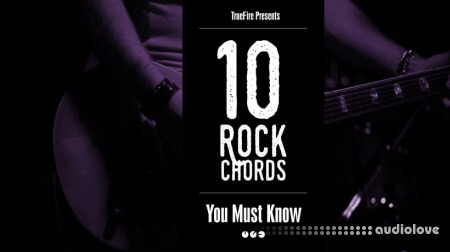Truefire Jeff Scheetz's 10 Rock Guitar Chords You MUST Know

Learn How to Play Thousands of Hit Rock Songs with These Must-Know Guitar Chords
We often hear beginners fretting about the sheer number of chords in music theory. But here's a secret: you don't need to master hundreds of chords to rock thousands of songs. Today, we're focusing on 10 power-packed chords that are the cornerstone of many popular rock tunes.
Before we dive into the chords, it's crucial to understand what 'root' means. The root note is the first note of a chord, and it typically defines the chord's name. For instance, in a C Major chord, 'C' is the root note. In our list, we will refer to 'Root 6' or 'Root 5', indicating the string on which the root note of the chord is played (6 is the thickest string and 1 the thinnest).
Let's break down these rock star chords:
Root 6, Power Chord
Root 5, Power Chord
Root 6, Major Chord
Root 6, minor Chord
Root 4, Power Chord
Root 5, Major Chord
Root 5, minor Chord
Dominant 7th #9 Chord
Root 6, sus2 Chord
Root 4, Major Chord
The magic of these chords lies not just in their individual prowess, but more importantly, in the myriad ways they can be combined to form popular rock chord progressions. A chord progression is a series of chords played in sequence.
I-IV-V (1-4-5) progression: This is possibly the most common progression in rock music, and it heavily uses Root 6 Major, Root 5 Major, and Dominant 7th #9 chords. A classic example is "Johnny B. Goode" by Chuck Berry, which uses a Bb- Eb- F progression.
ii-V-I (2-5-1) progression: Typically associated with jazz but also widely used in rock, this progression often uses Root 6 minor, Root 5 Major, and Root 4 Major chords. Check out "Blackbird" by The Beatles for a classic use of this progression.
I-V-vi-IV (1-5-6-4) progression: This progression tends to use Root 6 Major, Root 5 Major, Root 5 minor, and Root 4 Major chords. A perfect example of this progression can be found in "Let It Be" by The Beatles.
vi-IV-I-V (6-4-1-5) progression: This can be considered the pop-punk progression and generally uses Root 6 minor, Root 4 Major, Root 6 Major, and Root 5 Major chords. "When I Come Around" by Green Day offers an example of this progression.
I-♭VII-IV (1-b7-4) progression: A favorite of the grunge era, this progression often features the Root 6 Major, Dominant 7th #9, and Root 5 Major chords. Listen to "Smells Like Teen Spirit" by Nirvana for this progression.
The Power chord - both Root 6 and Root 5: is also fundamental to rock, used in songs like "You Really Got Me" by The Kinks and "Smoke on the Water" by Deep Purple. Lastly, the sus2 chord, while not as common, lends a distinctive sound to songs like "Boulevard of Broken Dreams" by Green Day.
Remember, knowing these chords and progressions is only part of the equation. Practice and experiment with different rhythmic patterns, strumming techniques, and dynamics to create your rock masterpiece.
You'll have all of TrueFire's advanced learning tools at your finger tips to personalize your workspace and learn at your own pace.
You can loop, slow down, or speed up any section of a lesson. Plus, all of the tab and notation is synced to the videos for the optimal learning experience. You'll also get tab and standard notation files to print out, Guitar Pro files, and all of the backing tracks to practice with.
Grab your guitar and lets rock!
Home page
DOWNLOAD
